Let’s face it—there has never been a better time to start learning how to grow weed outdoors (or in a greenhouse) than today.
There are many areas in the world that are famous for having great sun-grown cannabis, most notably Jamaica, California, Oregon and British Columbia. These 4 places reached legendary status in the growing game and here is why:
Lots of sunlight and high temperatures in the summer.
These are important factors when growing outside, so take that into account when planning your outdoor grow.
Later in the article, we’ll go a bit more in-depth about growing weed in soil and why you don’t see that many hydroponic outdoor grows.
But for now, let’s check out the growing equipment you’ll need for growing cannabis outdoors.
Equipment for growing weed outdoors
Cannabis growing equipment can be split into two types:
- Gear that is absolutely essential for growing cannabis
- Optional equipment that will help you produce higher yields
In this case, the most expensive thing on your list will be a greenhouse, and greenhouse prices depend on the type of the structure. I strongly suggest you get a greenhouse as it will make things significantly easier, and while you are at it get a good one.
Don’t be afraid to spend $100 to $200 on a good greenhouse—the last thing you want is to find your plants dead because of hale or vermin.
Essential growing equipment:
- Feminized seeds or clones;
- Pots;
- Soil;
- Fertilizers;
- Perlite.
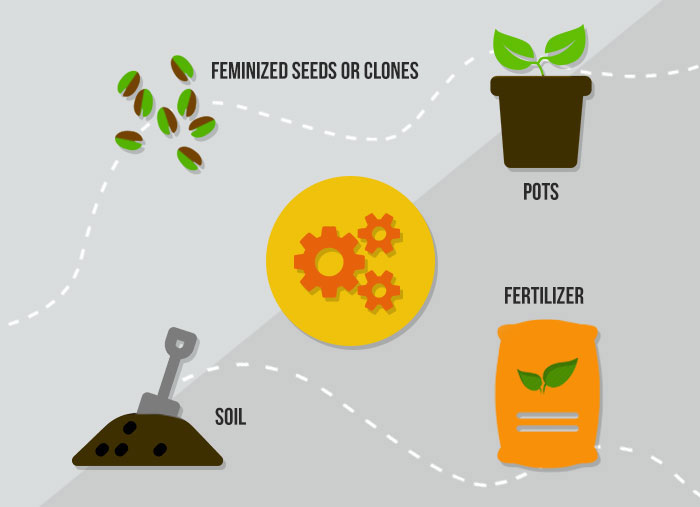
Optional growing equipment:
- Greenhouse;
- pH meter;
- Pesticides;
- Humidifiers and dehumidifiers;
- Fan.

Which strain is the best for outdoor growing?
Any strain can be grown outdoors, as all cannabis strains were initially grown outside before being brought indoors.
However, not every strain will yield the same results. Some strains are more adept at growing at higher temperatures, while others are used to growing in colder areas, and these plants are usually smaller.
So, naturally we want a strain with good genetics, and that it is traditionally grown outdoors for its potent yield.
Best indica strains for outdoor growing
Afghan Kush is one of the most popular Afghani strains. It started gaining in popularity in the ‘90s after US soldiers started bringing seeds home from Afghanistan.
Quickly after, they started crossing them with already established American and Dutch strains, thus the name Afghan Kush.
This strain is unusually tall for an indica, but still not as tall as an average sativa.
Afghan Kush has a decent yield (500-600 grams per plant) seeing how it doesn’t grow over 2 meters (80 inches). Its flowering time is 5-7 weeks. If you decide for this strain watch out for moisture and mold.
The other indica I believe is great for growing outside is Grape Ape, although this one might be a bit harder to grow.
Experienced growers say that this strain is better grown in water as the buds tend to grow bigger with good nutrient management, although growing it in soil works as well.
Some also note that you shouldn’t attempt to grow this strain outside if you don’t have a greenhouse.
Best hybrid strains for outdoor growing

Blue Dream is a hybrid cross between Blueberry and Haze, two very well known strains with good lineage and genetics.
Its flowering time is 9-10 weeks, which means that this strain might take a while.
However, don’t give up from growing Blue Dream just yet, as it has a huge upside. If you’ve never trained plants before, you will be able to do so with this one and get an even bigger yield than you might have expected.
Training cannabis plants significantly increases their yield, and this strain reacts well to all types of plant training. Also, Blue Dream can take high levels of nitrogen without burning so you don’t have to go easy on the nutrients.
On average, Blue Dream yields around 600 grams per plant when grown outdoors, with October being the best month for harvesting.
Trainwreck has been around for a minute now, and it is one of the best and easiest strains for growing outside.
It easily grows well over 2 meters and has a very potent yield—one plant can yield as much as 700 grams when grown outdoors.
It takes only about 8 or 9 weeks to flower, and you can also train and top it to further increase its yield. It’s not very susceptible to mold or rot so you should have an easy time growing this bad boy.
Lastly, Pineapple Express has been one of the most-in-demand strains over the last 10 years since the release of the movie that was named after the strain. This strain also takes around 8 to 9 weeks to flower, which is characteristic for crossed strains.
Pineapple Express is reasonably hard to grow in soil, especially outdoors, but the upside once harvested is just ridiculous. Don’t even think about growing this strain outside without a greenhouse as winds are the biggest enemy of Pineapple Express.
Best sativa strains for outdoor growing
Sour Diesel is a great pure sativa for growing outdoors because it quickly grows huge and it is fairly resistant to just about everything.
Sour Diesel is known for being more of a weed than a plant, as it can grow uncontrollably, without producing too many buds. You can control this by pruning, training, and topping your plants to keep them from getting out of control.
Also, if growing Sour Diesel outdoors, make sure it’s in a place where you’ll have warm weather until late September or early October, since it usually flowers after 11 or 12 weeks. If you do it right, Sour Diesel can yield around 650-700 grams per plant.
Maui Wowie is a classic Hawaiian strain which is perfect for growing outside. Flowering time is around 9 to 11 weeks and it has extremely big, thick buds and large yields.
Experienced growers say that this plant should be kept at around 25-30℃ and that it can handle high humidity and rain without a problem, so a greenhouse is not necessary for this strain.
Indoor vs outdoor weed growing: Essential differences
Growing cannabis indoors requires a lot of preparation and there are a lot of moving elements that can sometimes be forgotten—like turning your lights on or off.
It is also expensive if you are trying to make a return on investment by growing with high-powered lights to get a bigger yield.
However, the main difference in growing weed indoors and outdoors is in the growing medium, as purely hydroponic systems are basically non-existent in the world of outdoor growing.
Most of the outdoor growing is done in pots with soil, and some even choose to grow their trees from the Mother Earth itself, although I don’t recommend it.
Growing weed directly from the ground is one of the hardest things you can do as you have little-to-no control over your grow unless you plan on digging around your plant every now and then to add nutrients.
Another big difference is that outdoor-grown cannabis usually has lower THC levels as the lack of controlled environment is known to lower the levels of cannabinoids.
Weed grown outdoors is usually a few shades darker than what you’d expect high-grade weed to be, although this also depends a lot on the drying and curing process.
One thing is for sure, indoor grown weed, especially if grown in a hydroponic system, will always have a much stronger skunky smell and taste.
Growing weed indoors requires you to set up everything so that the plant thinks it’s still outside means that you won’t have to do this when growing outdoors, which is another bonus.
Why grow weed in a greenhouse?
Keeping your plants in a greenhouse is a pretty good idea, if you can afford it.
A greenhouse will help you control wind and pests, plus the temperature inside is usually a few degrees higher than the outside, which cannabis plants like.
Without a greenhouse, you risk weather harming your plants, as well as other unexpected things such as uninvited visitors.
I generally strongly advise in favor of getting a greenhouse because the control you get far outweighs the extra money you spend on it.
Greenhouse growing especially makes things easier when growing indica strains.
If you plan on growing Blue Dream or Trainwreck you won’t need it, but consider getting one for Pineapple Express.
If you plan on growing one of the sativa strains I recommended, don’t use a greenhouse as both Sour Diesel and Maui Wowie tend to grow huge and will quickly outgrow it.
How to grow weed outdoors (step by step)
As I already wrote an extensive article (and an eBook) about growing weed in soil (although in that instance I wrote about indoor growing), there isn’t much to be added here.
All the basic things that were mentioned in that article can be applied to this situation as well.
So, if you feel that I’ve skipped some important steps in my step-by-step guide here, feel free to fill in the gaps by peeking at the article linked below.
1) Prepare your grow
Make sure to choose a perfect location for your grow as this will have a big impact on the end result.
Keep in mind that you want your plants to get a lot of light, but not too much wind.
You will also need to prepare your pot by mixing Supersoil and Perlite (or something similar) in order to give your soil some air.
Adding a little bit of coco coir will also do wonders for the soil, as it will give roots more space to grow and they will be supplied with oxygen much more.
Now, I’ve also seen people growing in the ground, digging up pits and using them several times over for multiple grows. They reported having twice as big yields as when compared to growing in pots. However, this will expose your plants to numerous problems which can sabotage your grow, such as pests and bigger animals like cats and birds.
Mix 2 parts of your Supersoil with one part Perlite in the pot, as this ratio will give your plants the best access to oxygen through their roots.
2) Germinate seeds
Germinating is when a young plant leaves its seed and starts developing into an “organism” of its own. It is very simple to do this, and the only thing to keep in mind is that healthy cannabis seeds should float in water, and sink after spending some time in the water as they absorb it.
If you still don’t know how, here are 3 ways to germinate seeds.
After you’ve germinated and planted your seeds, all you have to do is wait for the plant to grow.
If you’re going with a clone, put it in a pot with some dirt and, voila, you just potted your first plant.
3) Water your plants
Water them whenever you feel that the top of the soil is dry and make sure that the water isn’t collecting at the bottom of the pot.
Make sure you don’t over-water the pot with the seed. Overwatering is one of the biggest mistakes you can make.
Here are my 5 general rules of watering cannabis plants:
- Flush soil before planting;
- Water whenever you feel that the top of the soil is dry;
- Bigger pots — water less often, smaller pots — water more often;
- Make sure you have appropriate draining (to avoid overwatering);
- Flush soil two weeks before harvesting, and stop adding additives (nutes and ferts).
Never forget to add nutrients and fertilizers to your water when it’s time to do so. If you don’t add a growing fertilizer in the vegetative stage, your plant might not grow enough, or it might grow too slowly.
If you forget the blooming fertilizer, your plants will have smaller flowers which won’t weight that much, and you won’t have as big a yield as you might have expected.
4) Train your plants
After they’ve grown and started looking like real plants and not just some dandelions, start training plants to get bigger yields.
There are several plant training techniques, however, topping is the most popular one if you’re growing big outdoor plants. Check out the post below for more info.
Outdoor-specific plants are also perfectly suited for topping, as these strains are known to grow to monstrous sizes. Some strains, especially hybrids with a higher sativa presence, are known to grow extremely tall, easily over 3m (10 feet) tall.
Now, if you were to top these plants, you could easily increase the yield by two or maybe even three times, depending on how skilled you are in training plants.
Having one plant with which you can play around and practice your training techniques will prove to be very much worth your time and effort, as knowing how to train plants is a great skill to have.
You can’t learn this in school, only through practice.
5) Don’t forget pesticides
This is a huge mistake many people make.
Add growing and blooming fertilizer to your water when watering the plants.
You’ll also want to get pesticides in case your plants are harassed by animals, especially insects. Keeping your plants protected is a must, which is why I always say getting a greenhouse is a good idea.
Once you get the hang of how simple growing weed outdoors can actually be, you’ll forget all about wanting to grow it inside, in complex hydroponic systems.
As I’ve mentioned before, cannabis grown in water usually has a stronger smell, and can often taste a bit like the chemicals used for fertilizing the plants. These plants are also usually smaller than outdoor ones and have a bigger yield due to the controlled environment.
Cannabis grown in soil smells much more pungent and has a nice aftertaste. Plants tend to grow huge, sometimes over 4 meters, and even up to 6 meters if kept in the vegetative stage for long enough.
Soil-grown plants can be a bit tough to control or even harvest on your own due to the sheer size of their colas and nugs. I’ve heard stories of people harvesting a whole pound easily off a 3.5m tall plant, so you can see why little investment in plant training can go a long, long way.
Enjoy growing outside and feel free to send us pics of your outdoor grow!



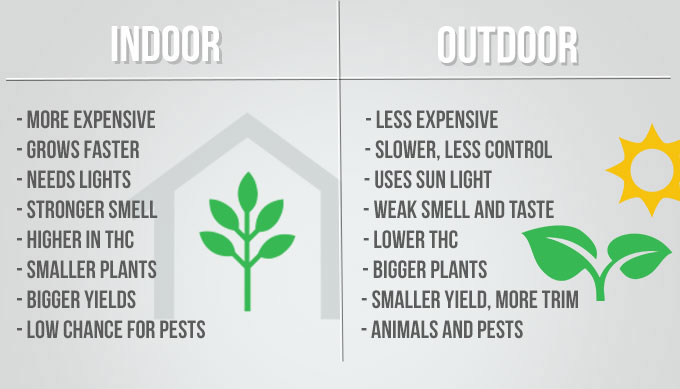
![How to Grow Weed Indoors for Beginners [Follow-Along Guide]](https://greencamp.com/wp-content/uploads/2017/05/how-to-grow-weed-200x200.jpg)
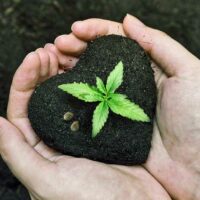
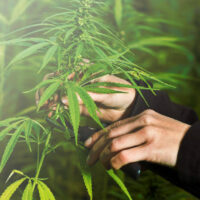

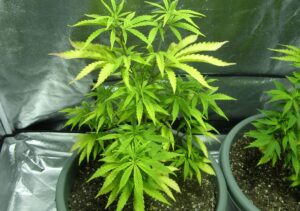


Dickens Cider August 25, 2018 at 8:22 am
I don't like hydro, it's popular on the black market, which I avoid. It does not have the same 'body' as soil grown plants. It gives an instant euphoria, but the effects are fleeting, too much gives you a headache. I believe relying on amateurs who are profit driven do not care for their plants, and do not flush them. I have my own formula, aged manure, fresh has too much nitrogen, some banana skins for the phosphorous, potash. NPK basically. I've grown plants in buckets in apple trees, in vines, in hanging baskets, it's fun to grow, and you can grow a guerilla garden in plain sight. I had a friend grew cannabis in a glass house alongside Tomatoes, she painted ping pong balls red and hung them in the weed trees, the mind simply sees all tomatoes. In a world where this activity is illegal (thats not unlawful) smell is the biggest giveaway, so plant amongst a herb garden for cover, grow it espallier along the ground, among the roses on the street front, people don't suspect, hidden in plain sight...
Alex September 6, 2018 at 10:06 am
That sounds great man, all that organic stuff must make your weed real tasty! I've also heard of people guerilla growing in the city like that, however, I've never been a big fan of risk. Maybe one day I'll have a garden like your friends!
Christian May 8, 2020 at 7:36 pm
Finally! Someone that’s not “profit driven” Thanks man We need more people like you
philipsmatkar August 30, 2018 at 8:12 am
Hi, I just want to ask if someone has any idea on which marijuana strain would be very effective when it comes with anxiety attacks and sleep disorder? I've been suffering for almost 2 months now and mostly can't sleep properly at night. I refrain my self on taking meds coz it seems doesn't work for me. So I started reading some alternative way for my problem and came across this article about querkle from https://eu.gyo.green/tga-subcool-seeds-querkle-tga-qkl-r.html/ and how it could help you relax but the problem is I don't smoke. But then I also found out that you can also make drinks or tea and even muffin/cake as an option aside from smoking it. Why they can't just simply make a pill out of marijuana if they say it could really be some help? Or maybe there are that I'm not aware of. If this is true I would gladly want to hear any of your experience and thoughts regarding this. Thanks in advance
Alex August 30, 2018 at 8:35 am
Hi there! The best strains to handle your anxiety attacks would be Granddaddy Purple and Girl Scout Cookies. As for your sleeping disorder, you can always go with Granddaddy Purple for that as well, but many other hard-hitting indica strains can do the job such as Afghan Kush, Northern Lights and any variation of the Big Bud strain. You can also find many other strains and match your symptoms and needs to a variety of strains using our Strainblazer tool.
Louise Brooks May 17, 2021 at 11:45 pm
The prescription cannabis pill is called Nabilone. Comes in different strengths. I now take coconut butter laced with cannabis and make chocolates. Have diminished my meds for restless legs by half and get a good nights sleep
Gary Torlone September 5, 2018 at 9:50 am
Will you please post information on growing organically instead of promoting pesticide use? Thank you.
Alex September 5, 2018 at 10:31 am
Well Gary, if you don't like growing with pesticides you are welcome to skip that step. I don't like my weed being attacked by pests as I've had the chance to see what it can result with. Just recently a friend of mine had to toss 8 plants because his plants somehow contracted almost everything from aphids to slugs. People put a lot of effort in growing, and I don't want them coming back in their 9th week to tell me they are having mites and barnacles and its all my fault because I forgot/didn't put pesticides in the article.
Esteban El Mexicano September 20, 2021 at 7:23 pm
Dish soap. Mix it 4-to-1 or so and spray it on the plants. Soap is still a "chemical", I guess, but it's not Malathion. And it washes off in the rain (so you need to reapply from time to time). I use it for scale, caterpillars, mealy bugs ... everything really.
Romeleo February 12, 2019 at 9:35 am
Sup alex.the name is Romeleo.ive never grown and have never composted and made my own dirt nutrients but I've done alot of extensive research on both subjects.my compost dirt will be ready this spring and I added alot of special ingredients to it and every one is reserched for it's benefits.all organic and all of Wich helps in every stage of the plant.things such as azomite volcanic rock powder,apples Wich are good for there ethenel Wich is a natural feminization chemical for the weed plant. citrus peels, banana peels,IPA beer and much more.all balanced and recorded for experimental study purposes.i even done research on the frequency of plants vibrations and the connection it has with it's growth factor and am going to do a separate plant experiment with a device I will attach to the main stem to see if my hypothesis is correct based on my studys..once it's a success I will let you know the results.one of the seeds I will be growing that I was fortunate to acquire through a bud I purchased is called The One.ironic to me due to the situation I'm creating for my first ever composting and weed growing experiment.its crossed between pure Afghan and thai.peace✌️
Alex February 12, 2019 at 9:38 am
That sounds dope man make sure you sends us some photos! Also, if you need more help while you are growing, you can find experienced growers sharing photos and advice on r/microgrowery on Reddit. Also, there is a Facebook group called Cannabis Growers Helping Growers which is pretty much the same.
Romeleo February 12, 2019 at 9:38 am
I heard of driving nails into the cola Wich made it grow thicker and faster buds.do you know of any instances where that has accured
Alex February 12, 2019 at 9:40 am
No definitely don't do that it will only hurt the plant
Lunar Gardener April 1, 2019 at 10:37 am
I disagree Growing inside or outside a basic tunnel in the ground, using organic methods is great, providing you prepare the hole and soil properly. You are using sunlight and an endless supply of root space, your plants are protected and can grow to great heights. My outdoor yield kicks ass!!!
Sam Farrow April 28, 2019 at 12:00 pm
Hi just wondering how you can flower outdoors? does the plant flower itself flower or do you need to take the plant indoors for more time in dark for the plant to flower? Hope this makes sense as i am a first time grower. Any response is appreciated Thanks Sam
KingJ May 2, 2020 at 10:53 am
It will flower in its own when Mother Nature starts bringing the sun down earlier. Where I am this usually happens beginning to mid august..
Jrocks June 6, 2020 at 8:57 pm
Your plants will flower on their own when they sense for about a week that they aren’t getting over 12 hours of continuous light. If your grow area has shady times of the day that can affect how much light it gets, and thus when it will start to flower. My backyard gets great sunlight starting around 10 am, but early morning the light is not very strong because of shadows from houses and trees. This means that my Gelatos planted in early April start flowering in mid May. 8-10 weeks later. I get 3foot tall plants, that I top, and the yields are fantastic. You can also manipulate it a little by moving your pots around to get more sun, but if they consistently get less than 12 hours of solid sunlight they will flip automatically. Hope this helps. -J
Bill Smith April 28, 2019 at 12:02 pm
Hi i am a first time grower and have a question about flowering. Can your plants flower outdoor in UK or do you have to bring them indoors so they get enough light/darkness. or can you just leave it outside and it will flower on its own? thanks Bill
erle b schucker April 11, 2020 at 4:38 am
you can speed up the process of flowering outside by using dark plastic to cover your grow . you'll have to put posts alittle taller than your girls , on all 4 corners to attach the plastic too ! and you have to be very vigilant in covering and uncovering , but its only usually necessary for a couple extra weeks over mother nature to make sure your strain you've chosen will reach full budding cycle and yield as much as it can with the expected THC levels ! Works very well in eastern Ore . 50 plant outdoor grow several times ! b,
tich January 10, 2020 at 8:01 pm
no your plant will flower on it,s own when the sun starts to go down earlier we get less hrs of sunin the fall sept.-Oct.
Michael March 23, 2020 at 9:42 am
10parts water 1 part dish soap is a great pesticide, keeps the buggs away and wont harm ur plants
Bryon Payne April 30, 2020 at 11:46 am
Can you please post a reference to your claim that outdoor has less THC than indoor. I have never heard that.... actually have heard the exact opposite....and I've been smoking for 25 years, growing for 5. I've never run THC tests on my buds but my outdoor harvests are always as good or better both taste wise and high wise than my indoor harvests. And your statement that indoor will have bigger yields is 100% non factual and simply your opinion. I am just curious...how long have you been growing weed and/or what's your qualifications to be writing articles like this? Thanks
Ana Stanojevic May 4, 2020 at 10:42 am
Thank you for your comment! Indoor vs. outdoor weed in terms of potency is definitely a debatable issue, you'll find many opposing opinions. Here's one high-authority cannabis website that shares our view: https://www.leafly.com/news/growing/indoor-vs-outdoor-cannabis-growing-3-key-differences
Robbie September 28, 2021 at 6:01 pm
Right on, Byron. My outdoor grow this year (Ontario) had 8.5 ft heights and a huge yield - no plant training, no pesticides, no fertilizer. Find the right environment and Mother Nature will do most of the work. Even my rush-dried tasters are smooth and as potent as the store-bought stuff. Lots of work at harvest time, but satisfying.
Robbie September 28, 2021 at 6:03 pm
Bryon
Jess March 14, 2021 at 1:02 pm
Hi, Do you have any recommendations for growers starting seeds indoors and then moving plants outside. I have Jacked-up seeds. I want to germinate and start the grow inside under lights then put them outside when its warm enough. I live in CT and it stays fairly chilly here until mid-may. Any advice is greatly appreciated.
Renee April 17, 2021 at 7:05 pm
This article is helpful. I have never grown before, but having gotten a medical cannabis card I'm looking to grow my own and save some money. I want to do it outside. My husband can build a greenhouse. What strains would you recommend for pain relief, anxiety, help sleeping? I'm looking for a single strain that would be good for all three. I have back pain and nerve pain in my leg due to my back condition. Thank you in advance. Renee